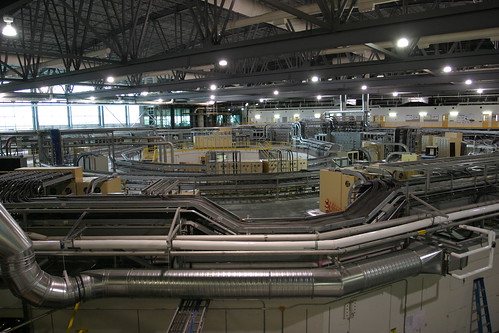Just saw a pretty neat talk on lithography using block co-polymers by Paul Nealey of the University of Wisconsin:
(above: a figure from Nealey's recent Science paper)
Block copolymers are cool for lithiography because you can take a copolymer, put it on your substrate, and it will magically and spontaneously form into a pattern! If you can figure out what polymers and conditions to use, you can control the pattern, including the size and type of features. In comparison, other techniques require complicated steps such as multiple mask/etches or fancy pants equipment like an e-beam.
The way it works is that you take two monomers that don't want to be near each other, like polystyrene (nonpolar) and polymethylacrylate (polar), and chemically bond them to make a block co-polymer. It's like making boys and girls in grade school dance together; they ain't having none of those cooties, so they position themselves as far away as possible. In the case of copolymers, you can get features such as dots, cylinders or lamellae (fancy word for strips), and depending on the molecular weight of the polymers, you can control the size down to the nanoscale. 
Reprinted by permission from Nature: Nealey et. al, Nature 424 (6947), pp. 411-414.
What Nealey has done that's pretty cool, is found a way to force the cootie-separation (techical term) in an incredibly regular and repeating fashion. He accomplishes this by pre-patterning the substrate[1] to increase difference in the surface energy between the two monomers. Some of the examples he gave showed perfect lamellae of 25 nm width and 250 nm height stretching out for hundreds of microns (almost millimeters!).
The size of features of block co-polymers is smaller than other conventional patterning techniques, and therefore this lithography approach has tons of interest from the semiconductor industry. Nealey even stated that a collaboration he is doing with an industrial partner could lead to block copolymer lithography being used in hard drives with storage densities of 1 TB / sq. inch!
Really cool talk on an awesome-sauce field. Hope to hear more on this!
References:
1. R. Ruiz, H. Kang, F. A. Detcheverry, E. Dobisz, D. S. Kercher, T. R. Albrecht, J. J. de Pablo, P. F. Nealey; "Density Multiplication and improved lithography by directed block copolymer assembly,"Science, 321(5891), 936-939 (2008).
2. S. O. Kim, H. H. Solak, M. P. Stoykovich, N. J. Ferrier, J. J. de Pablo, P. F. Nealey; "Epitaxial self-assembly of block copolymers on lithographically defined nanopatterned substrates," Nature, 424(6947), 411-414 (2003).
[1] The pre-patterning step might seem to render all of this excitement baloney. Why go to all the effort of applying the polymer to the surface when you already have to pattern it with something else? The answer is that Nealey doesn't have to pattern the whole surface; just enough of it to tip the surface energy balance in favour of the repeating, regular pattern. In the Science paper referenced above, his group achieved a "density multiplication" of 4 times.
Tuesday, January 13, 2009
Nanolithography by block copolymers
Subscribe to:
Post Comments (Atom)

No comments:
Post a Comment